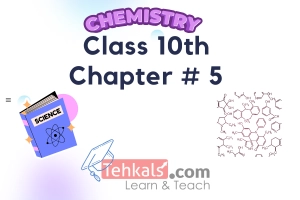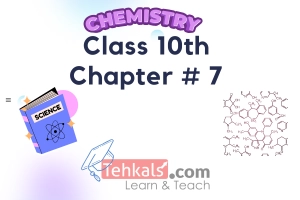Chemistry Class 10 Chapter 6
Published: 15 Dec 2023
Chemistry Class 10 Chapter 6 introduces the concept of “Environmental Chemistry I: Atmosphere”. This is mainly chapter No. 14, “Environmental Chemistry I: Atmosphere”, of the book of Class 10.
This article consists of Notes, SLO Based Notes and MCQs of chemistry, which cover your course, board papers and clear your chemistry concept for different types of tests.
Chemistry Class 10 Chapter 6 Notes
Environmental Chemistry I: Atmosphere
SLO Base Questions
Chemistry Class 10 Chapter 6 MCQs
1. About 4.5 billion year ago, the earth at the time of its formation was a hot mass, which could not sustain.(a) life
(b) Metals
(c) Pressure
(d) Matter
Show Answer
life
2. The earth than cooled gradually and due to of steam into water, formation of atmospheric gases and ozone layer in atmosphere made earth suitable for life .
(a) Evaporation
(b) Condensation
(c) Boiling point
(d) Melting point
Show Answer
Condensation
3. The branch of chemistry which deal with the study of environment and change occurring in it is called —–chemistry
(a) Physical
(b) Organic
(c) Environmental
(d) None of these
Show Answer
Environmental
4. The thick protective blanket of gases around the earth which helps to sustain life is called ——.
(a) Atmosphere
(b) Biosphere
(c) geosphere
(d) None of these
Show Answer
Atmosphere
5. The major constituents of atmosphere are ——–
(a) $ CO_2, CH_4 $
(b) $ N_2, O_2 $
(c) $ N_2, CH_4 $
(d) None of these
Show Answer
$ N_2, O_2 $
To Download Complete Notes of Chemistry Notes 10 Class, Click on the given link.
6. An increase in attitude wills—-the density of atmosphere.(a) decrease
(b) increase
(c) constant
(d) None of these
Show Answer
decrease
7. Atmosphere is responsible for sustaining life on earth ,as it contain ________ which is necessary for living things.
(a) food
(b) oxygen
(c) Carbon dioxide
(d) None of these
Show Answer
oxygen
8 . Atmosphere also absorbs the dangerous ——-radiation coming from the sun and act as a protective layer
(a) Ultra violet
(b) cosmic
(c) Solar wind
(d) All of them
Show Answer
All of them
9. The atmospheric gases that are used in respiration and photosynthesis is called—-
(a) air
(b) oxygen
(c) Carbon dioxide
(d) None of these
Show Answer
air
10. The composition of atmosphere is—–
(a) Constant
(b) variable
(c) Equal
(d) None of these
Show Answer
variable
11. Atmosphere change according to time and ——-
(a) place
(b) pressure
(c) temperature
(d) None of these
Show Answer
place
12. Atmosphere is the mixture of different types of gases including—-
(a) Water vapours
(b) Dust particles
(c) both
(d) None of these
Show Answer
both
13. ——of atmosphere is made up of nitrogen and oxygen.
(a) 99%
(b) 95%
(c) 75%
(d) 90%
Show Answer
99%
14. The mass of atmosphere is approximately 4.5 to ______ metric tons.
(a) $ 5 \times 10^5 $
(b) $ 5 \times 10^{10} $
(c) $ 5 \times 10^{15} $
(d) $ 5 \times 10^{20} $
Show Answer
$ 5 \times 10^{15} $
15. The density of atmosphere is——which gradually decrease with altitude.
(a) $ 0.0013 \ g/cm^3 $
(b) $ 0.0130 \ g/cm^3 $
(c) $ 1.03100 \ g/cm^3 $
(d) None of these
Show Answer
$ 0.0013 \ g/cm^3 $
16. Generally atmosphere extends up to —–from earth’s $ g/cm^3 $
(a) 300 km
(b) 500 km
(c) 700 km
(d) None of these
Show Answer
500 km
17. The temperature of atmosphere decreases up to —-.
(a) $ -92 {}^o C $
(b) $ -90 {}^o C $
(c) $ -87 {}^o C $
(d) $ -83 {}^o C $
Show Answer
$ -92 {}^o C $
18. The temperature of atmosphere increases up to——–
(a) $ 1500 {}^o C $
(b) $ 1000 {}^o C $
(c) $ 1200 {}^o C $
(d) $ 800 {}^o C $
Show Answer
$ 1200 {}^o C $
19. The pressure of atmosphere at sea level is —-but at high attitude it decreases.
(a) 5atm
(b) 1atm
(c) 10atm
(d) -3atm
Show Answer
1atm
20. There are the —–main layers of atmosphere.
(a) four
(b) five
(c) three
(d) six
Show Answer
four
21. The first layer of atmosphere which closest earth surface is called —–
(a) Mesosphere
(b) thermosphere
(c) troposphere
(d) None of these
Show Answer
troposphere
22. Tropo means —–
(a) change
(b) pungent
(c) colour
(d) None of these
Show Answer
change
23. We live in——.
(a) stratosphere
(b) troposphere
(c) mesosphere
(d) None of these
Show Answer
troposphere
24. The average height of troposphere from the earth s surface is about——.
(a) 5 km
(b) 8 km
(c) 11 km
(d) 31 km
Show Answer
11 km
25. Almost all of the dust particles and ——–are .present in this layer.
(a) Water vapours
(b) hydrogen
(c) krypton
(d) None of these
Show Answer
Water vapours
26. ——-of the atmosphere gases are present in this layer .
(a) $ 70-75 \% $
(b) $ 50-55 \% $
(c) $ 90-95 \% $
(d) None of these
Show Answer
$ 70-75 \% $
27. The change and temperature of atmosphere with an increase with height is called—–
(a) Allotrope
(b) Lapse rate
(c) Change rate
(d) None of these
Show Answer
Lapse rate
28. The average temperature near the earth surface is ——-.
(a) $ 15 {}^o C $
(b) $ 10 {}^o C $
(c) $ 20 {}^o C $
(d) $ 05 {}^o C $
Show Answer
$ 15 {}^o C $
29. The average temperature at the top of the troposphere is about ——-
(a) $ -30 {}^o C $
(b) $ -41 {}^o C $
(c) $ -56 {}^o C $
(d) $ -70 {}^o C $
Show Answer
$ -56 {}^o C $
30. Pressure, moisture, and density of air also —–with height.
(a) increase
(b) decrease
(c) constant
(d) None of these
Show Answer
decrease
31. The second layer of atmosphere which is above troposphere is called _____________.
(a) Stratosphere
(b) Mesosphere
(c) Exosphere
(d) Endosphere
Show Answer
Stratosphere
32. Strata is Greek word which means__________.
(a) Burn
(b) Above
(c) Spread out
(d) None of these
Show Answer
Spread out
33. Stratosphere stars at the top of troposphere and extends from 11km to _______above sea level.
(a) 25 km
(b) 39 km
(c) 50 km
(d) 57 km
Show Answer
50km
34. The major component of stratosphere is ____________.
(a) Ozone
(b) Oxygen
(c) Xenon
(d) Carbon dioxide
Show Answer
Ozone
35. The stratosphere contains the ozone layer at height of about.
(a) 18km
(b) 30km
(c) 42km
(d) 37 km
Show Answer
30km
36. Stratosphere is also called___________________.
(a) Ozonosphere
(b) Ionosphere
(c) Exosphere
(d) None of these
Show Answer
Ozonosphere
37. The stratosphere contains the ozone layer at a height of about.
(a) Decrease
(b) Constant
(c) increase
(d) None of these
Show Answer
increase
38. Which radiation breaks the ozone molecule into monotint and diatomic oxygen?
(a) CFCs
(b) UV-radiations
(c) HCFCs
(d) All of these
Show Answer
All of these
39. Weather balloons and jet air craft fly in _____as the air present in this layer is very thin.
(a) Stratosphere
(b) Mesosphere
(c) Troposphere
(d) None of these
Show Answer
Stratosphere
40 In stratosphere the temperature increases form -56o to ___________with height.
(a) $ 15 {}^o C $
(b) $ 0 {}^o C $
(c) $ -2 {}^o C $
(d) $ -56 {}^o C $
Show Answer
$ -2 {}^o C $
41. The increase in temperature of stratosphere is due to _______which absorbs uv-radiation from the sun.
(a) $ S_8 $
(b) $ O_3 $
(c) $ NH_4 $
(d) $ H_2 $
Show Answer
$ O_3 $
42. Mesosphere starts at the top of the stratosphere and extends from 50km to _______above sea level.
(a) 85 km
(b) 75 km
(c) 65km
(d) 95km
Show Answer
85 km
43. In mesosphere, the temperature decreases from $ -2 {}^oC $ to ____________.
(a) $ -100 {}^oC $
(b) $ 92 {}^oC $
(c) $ 100 {}^oC $
(d) None of these
Show Answer
$ -92 {}^oC $
44. Thermosphere is the $ 4^{th} $ layer of atmosphere ranges from 85 to ___________above the earth surface.
(a) 300 km
(a) 500 km
(a) 900 km
(a) 1200 km
Show Answer
500 km
45. In thermosphere, the temperature increases from$ -92 {}^oC $ to _________________.
(a) $ 500 {}^o C $
(b) $ 200 {}^o C $
(c) $ 1200 {}^o C $
(d) $ 2000 {}^o C $
Show Answer
$ 1200 {}^o C $
46. __________is a transitional space between earth’s atmosphere and outer space.
(a) Exosphere
(b) Thermosphere
(c) Mesosphere
(d) Troposphere
Show Answer
Exosphere
47. Atmosphere helps in ___________________.
(a) Maintaining normal temperature
(b) Radio communication
(c) Movement of aircrafts
(d) All of them
Show Answer
All of them
48. The excess discharge of any substance into environment which adversely effects the quality of the environment, cause damage to human, plants and animals is called________________.
(a) Global warming
(b) pollution
(c) Biotic life
(d) None of these
Show Answer
pollution
49. The substance released to air either by human or natural activities, in sufficient amount to cause harmful effects on humans, plants and animals is called___________.
(a) Air pollution
(b) Land pollution
(c) Water pollution
(d) All of these
Show Answer
Air pollution
50. The substances that are responsible for causing air pollution are called______________.
(a) Air pollutants
(b) Water pollutants
(c) Land pollutants
(d) None of these
Show Answer
Air pollutants
51. Pollutants can be in the form of ___________.
(a) Solid particles
(b) Liquid particles
(c) Gases
(d) All of these
Show Answer
All of these
52. There are the ________main types of air pollutants.
(a) 5
(b) 4
(c) 3
(d) 2
Show Answer
2
53. The substances which are released directly into air are called ____________pollutants.
(a) primary
(b) Secondary
(c) Tertiary
(d) None of these
Show Answer
primary
54. Which of them is a primary air pollutant?
(a) $ SO_x, NO_x $
(b) $ CO_2 $
(c) VOCs
(d) All of them
Show Answer
All of them
55. Those substances which are not produced directly and formed from the primary pollutants are called _____palutant.
(a) Primary
(b) Secondary
(c) Tertiary
(d) None of these
Show Answer
Secondary
56. Which of the following is a secondary pollutant?
(a) Ozone
(b) $ SO_2 $
(c) $ NO_2 $
(d) All of these
Show Answer
Ozone
57. Which of the following is a natural source of particulation?
(a) Volcanic eruption
(a) Soil erosion
(a) VOCs
(a) Both a and b
Show Answer
Both a and b
58. Which of the following is anthropogenic source of particulates?
(a) Wood burning
(b) Mining
(c) Mountain blasting
(d) All of them
Show Answer
All of them
59. Chlorofluoro carbons (CFCa) are a group of compounds which contain chlorine, fluorine and _________element.
(a) Nitrogen
(b) Carbon
(c) Helium
(d) Oxygen
Show Answer
Carbon
60 CFCs are used as a propellant in ___________.
(a) Aerosol spray
(b) refrigerators
(c) Air-conditions
(d) All of them
Show Answer
All of them
61 ________in CFCs catalyzes the conversion of ozone to oxygen atom and molecule.
(a) Chlorine
(b) Carbon
(c) Fluorine
(d) Bromine
Show Answer
Chlorine
62. The chlorine atom in CFCs has the ability to destroy a large amount of ______________.
(a) $ H2SO_4 $
(b) $ HNO_3 $
(c) $ O_2 $
(d) $ H_2CO_3 $
Show Answer
$ O_2 $
63. Carbon monoxide is a ________________gas.
(a) Colorless
(b) Odorless
(c) Poisonous
(d) All of them
Show Answer
All of them
64. Carbon monoxide combines with hemoglobin and reduces the oxygen-carrying capacity of ___________.
(a) Blood
(b) Cells
(c) Gills
(d) Chills
Show Answer
Blood
65. __________damages the contract nervous system causes blurred vision, headache, nausea and a sudden death.
(a) $ CO_2 $
(b) $ NaCl $
(c) $ CO $
(d) $ HCl $
Show Answer
$ CO $
66. ________causes respiratory problems, irritation of eyes, nose and throat, pneumonia, damage to leather , iron, steal etc.
(a) $ SO_2 $
(b) $ CO $
(c) $ CO_2 $
(d) $ NO $
Show Answer
$ SO_2 $
67. Polyaromatic compounds (PAC) and polyaromatic hydrocarbons(PAH) are _____compounds which can cause leukemia and other diseases.
(a) Conductor
(b) carcinogenic
(c) Acidic
(d) Bad conductor
Show Answer
carcinogenic
68. The rain having pH less than 5.6 is called__________.
(a) Acid rain
(b) Neutral rain
(c) Basic rain
(d) None of these
Show Answer
Acid rain
69. Acid rain destroys vegetation and cause damage to ____________.
(a) Human skin
(b) Hair
(c) Monuments
(d) All of these
Show Answer
All of these
70. The process of enrichment of water by salts that causes changes in ecosystem is called _________.
(a) Eutrophication
(b) Acid rain
(c) Ozone depletion
(d) None of these
Show Answer
Eutrophication
71. Pollutants decrease the concentration of ozone below its normal level in stratosphere coursing —-
(a) Global warming
(b) Ozone depletion
(c) Acid rain
(d) None of these
Show Answer
Ozone depletion
72. Normal rain water is slightly acidic with a pH range of —–
(a) $ 5.6-6 $
(b) $ 3.9-5.6 $
(c) $ 6-7.4 $
(d) None of these
Show Answer
$ 5.6-6 $
73. The most acidic rain having least pH value of—-has been reported until now.
(a) $ 3.1 $
(b) $ 2.1 $
(c) $ 4.1 $
(d) $ 1.1 $
Show Answer
$ 2.1 $
74. Acid rain is one of the adverse effects of ——
(a) Air pollution
(b) Land pollution
(c) Water pollution
(d) non
Show Answer
Air pollution
75. Acid is the result of—–in the atmosphere.
(a) $ CO_2 $
(b) $ SO_2 $
(c) $ NO_2 $
(d) All of them
Show Answer
All of them
76. Acid rain generally leads to ——
(a) Weathering of building
(b) Corrosion of metals
(c) Peeling of paints
(d) All of them
Show Answer
All of them
77. At pH ——most fish eggs cannot hatch .
(a) 5
(b) 7
(c) 9
(d) 12
Show Answer
5
78. At pH less than 5 ,some adult fish may —–.
(a) Migrate
(b) Hibernate
(c) Die
(d) non
Show Answer
Die
79. Who can tolerate the condition of around $ pH-4 $ ?
(a) Fish
(b) Frog
(c) snake
(d) non
Show Answer
Frog
80. At ——–attitude , acidic fog and cloud decrease the nutrients from trees and plants.
(a) high
(b) Intermediate
(c) lower
(d) non
Show Answer
high
81. The —-is soluble in water and washed away with rainwater .
(a) $ CaCO_3 $
(b) $ CaSO_4 $
(c) $ H_2CO_3 $
(d) $ H_2SO_4 $
Show Answer
$ CaSO_4 $
82. The acidic particle corrode ——and cause paint and stone to deteriorate more quickly .
(a) Alkali metals
(b) Non metal
(c) All metal
(d) non
Show Answer
All metal
83. Ozone is an —–from of oxygen consisting of three chemically bonded oxygen atoms.
(a) Allotropic
(b) Crystalline
(c) amorphous
(d) non
Show Answer
Allotropic
84. The ozone name was given by the scientist—-in 1840.
(a) Emiliano
(b) schonbein
(c) Christopher
(d) non
Show Answer
schonbein
85. Ozone is derived from a —–word ‘’ozoaterr’’ wich mean smell.
(a) Greek
(b) Latin
(c) Persian
(d) non
Show Answer
Greek
86. The ozone layer is present in——
(a) troposphere
(b) stratosphere
(c) mesosphere
(d) None of these
Show Answer
stratosphere
87. The molecular formula of ozone is —–
(a) $ O_3 $
(b) $ O_2 $
(c) $ O $
(d) None of these
Show Answer
$ O_3 $
88. Ozone is present in the lower part of stratosphere also called as —–.
(a) Ionosphere
(b) Exosphere
(c) Ozonosphere
(d) None of these
Show Answer
Ozonosphere
89. Ozone is a ——-colour gas.
(a) reddish
(b) purple
(c) bluish
(d) None of these
Show Answer
bluish
90. The decrease in the concentration of ozone in stratosphere below its normal level is called —-
(a) Global warming
(b) Ozone depletion
(c) desertification
(d) None of these
Show Answer
Ozone depletion
91. About 80 % of ozone depletion occurs due to ——
(a) CfCs
(b) Fossil fuels
(c) Forest fire
(d) None of these
Show Answer
CfCs
92. Ozone layer damages the ——.
(a) Skin cancer
(b) Cause cataract
(c) Aging of skin
(d) All of them
Show Answer
All of them
93. The increase in average temperature of the earth s surface as well as its atmosphere is called —-
(a) Green house effect
(b) Global warming
(c) Ozone depletion
(d) None of these
Show Answer
Global warming
94. $ CO_2, CH_4 , NO_2 \ and \ O_3 $ are called ——-gases .
(a) Green house
(b) noble
(c) hydrocarbons
(d) None of these
Show Answer
Green house
95. Without Green house effect temperature on earth would be ——.
(a) $ 15 {}^o C $
(b) $ -18 {}^o C $
(c) $ 30 {}^o C $
(d) $ -30 {}^o C $
Show Answer
$ -18 {}^o C $
96. What is the effect of global warming ?
(a) desertification
(b) Sea level rise
(c) cyclones
(d) All of them
Show Answer
All of them
Chemistry Class 10 MCQs (All Chapters)

- Be Respectful
- Stay Relevant
- Stay Positive
- True Feedback
- Encourage Discussion
- Avoid Spamming
- No Fake News
- Don't Copy-Paste
- No Personal Attacks



- Be Respectful
- Stay Relevant
- Stay Positive
- True Feedback
- Encourage Discussion
- Avoid Spamming
- No Fake News
- Don't Copy-Paste
- No Personal Attacks





